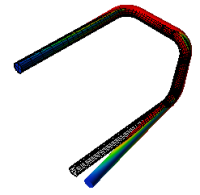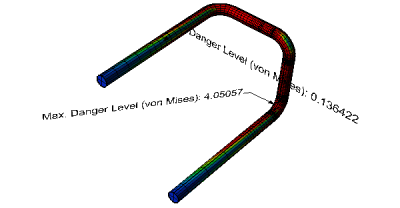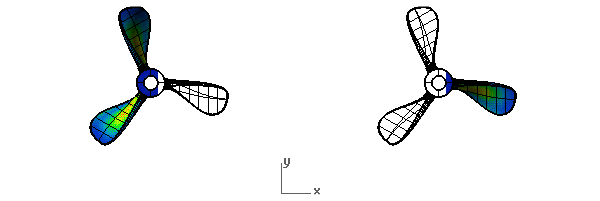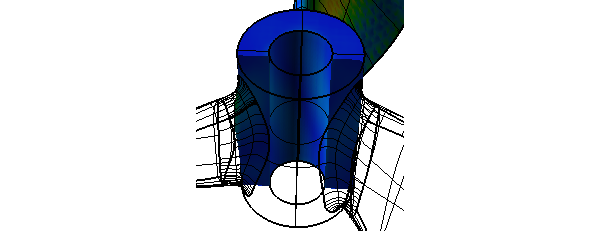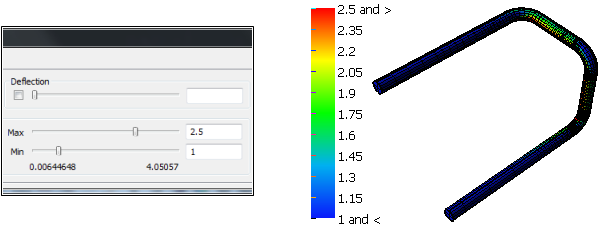Table of Contents
Options and Controls
Scan&Solve offers several options and controls that can be used to analyze results. There are two main result viewing categories: Simplified View and Advanced View.
Simplified View
Simplified view provides basic controls to visualize solution results.
Component combo box selects the active solution component. In the simplified view the available solution components are limited to material-dependent danger levels and total displacement.
Deflection slider controls the scale of the deflection for the solution geometry. (details)
[Minimum], [Point], and [Maximum] place markers on the geometry. (details)
Section controls the dynamic section plane functionality. It includes controls to toggle the section plane on/off, and change the orientation and direction of the section plane. (details)
[Advanced] enables more solution viewing options, including additional solution components, selectable color scales, and adjustable legend ranges. (details)
[Bake] writes the deflected geometry to the Rhino document. (details)
[Report…] generates a web-ready report of the solution. Details on modifying the standard reports may be found here.
Deflected View
The Deflection slider provides an interactive mechanism for visualizing the magnified deflection the geometry experiences under the specified loads and restraints. In addition to the slider method of entry, a numeric value may be entered in the edit box. The deflected shape is the result of a linear extrapolation of the static displacement and should not be construed as the actual deflected shape.
The following is an example of a solid that has been deflected. The wireframe shape represents the original view of the solid, the rendered shape is the deflected view.
For more on studying deflection, read this document.
Point Queries
Scan&Solve™ will place leaders in the model pointing out the location and value of the displayed solution quantities. These leaders will only display under view types that will also allow annotations to be displayed (wireframe, shaded, ghosted, x-ray). The leader text size is controlled by Rhino's dimension scale and text height settings.
The marking capabilities are accessed through the following three buttons:
[Minimum] marks the location of the minimum value of the active solution component.
[Point] marks the value of the active solution component at a point selected on the model.
[Maximum] marks the location of the maximum value of the active solution component.
Example
The following is an example of a solid with a point query placed at the Maximum and at a random point.
Section Planes
Dynamic section planes can be used to examine the solution results in areas of the solid that are normally difficult to see or inaccessible. Examples include the interior of the solid, or small crevices obscured by other parts of the solid.
Toggle On/Off
Check the [On] box to turn section planes on or off. The current settings will be preserved while section planes are toggled off.
Change Axis
The Axis controls change the orientation of the section plane to align with one of the three coordinate axes. Switch between them to find the most optimal view for the area to be examined.
Flip Direction
The Flip control is used to change the direction of the sectioned display. When unchecked, the filled area will progress from the negative direction to the positive direction of the axis. When checked, the filled area will progress from the positive to the negative direction of the axis.
Example
In the preceding model, the inner face of the tubular central shaft is completely obscured by the surrounding geometry, but with section planes the results can be examined.
Advanced View
Advanced view provides more visualization controls to aid interpretation of solution results.
Legend
- Color Scale combo box selects the legend color scheme for the active component.
- Font Face combo box selects the font face used for the current user's legends.
- [Annotation Color] button selects the color used for the current user's legends.
- Max slider controls the maximum value displayed on the legend. (details)
- Min slider controls the minimum value displayed on the legend. (details)
[Simplified] simplifies the solution viewing options. (details)
[Reset] resets the settings for the active solution component.
[Reset All] resets the settings for all solution components.
[ ] Retain Settings toggles whether the visualization settings for each solution component are retained between simulation runs.
Min/Max Ranges
In the Advanced View, the legend limits may be adjusted to bracket specified ranges of solution values. Different limits may be specified for each solution component.
Max slider controls the maximum value displayed on the legend. The adjacent edit box shows the current maximum legend value and supports manual entry of the maximum value.
Min slider controls the minimum value displayed on the legend. The adjacent edit box shows the current minimum legend value and supports manual entry of the minimum value.
The readouts under the sliders indicate the minimum and maximum values of the currently displayed component.
Examples
The following is an example of the unmodified Min and Max ranges, and their effect on the rendered solid.
The following is an example of modifying the Min and Max ranges, and the effect on the rendered solid.



